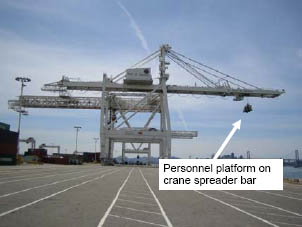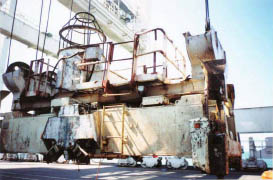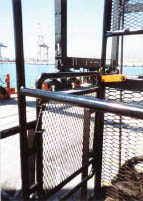
| U.S. Department of Labor |  |
|||||
| Occupational Safety & Health Administration | ||||||
 Marine Terminal Fall Protection for Personnel Platforms In marine terminals, personnel platforms attached to the container spreader of a container handling gantry crane are commonly used to transport workers, equipment and tools to and from container ships. The longshoremen then perform various tasks onboard the ship, such as disconnecting the twistlocks that hold cargo containers together, attaching and removing lashing equipment that secure the stacks of containers on the ship, and handling other problems that may arise. During the transport of longshoremen to and from container ships, the hazard of falling is a major concern for employers, ship owners, and the longshoremen.  General Precautions General Precautions Employers are required to ensure that employees use a personal fall protection system while working on top of a vessel’s containers (see 29 CFR 1918.85(j)). However, employers are not required to ensure that employees use the personal fall protection system while riding in a personnel platform. However, OSHA standards 29 CFR 1917.45(j) and 1918.66(c) provide safety requirements and procedures for longshoring employees who are being hoisted. Personnel Platform Recommendations To better protect employees, OSHA recommends that employers and employees implement the following safety precautions to ensure the safety of workers being transported on personnel platforms:
 Personnel platform with half gate Access Openings OSHA standards require that personnel platforms be equipped with an access opening fitted with a means of closure (see 29 CFR 1917.45(j)(8)). OSHA recommends that employers use personnel platforms equipped with a full gate system meeting the requirements of 29 CFR 1917.45(j)(1)(iii)(A). The gate should swing inward, be self-closing, and use a positive locking mechanism. If a chain closure is used, OSHA recommends that employers instruct their employees to stand away from the opening while being hoisted.  Personnel platform with locking gate This is one in a series of informational fact sheets highlighting OSHA programs, policies or standards. It does not impose any new compliance requirements. For a comprehensive list of compliance requirements of OSHA standards or regulations, refer to title 29 of the Code of Federal Regulations. This information will be made available to sensory impaired individuals upon request. The voice phone is (202) 693-1999; teletypewriter (TTY) number (877) 889-5627. For more complete information:
www.osha.gov (800) 321-OSHA |
||
| www.osha.gov | www.dol.gov | |
|
Contact Us | Freedom of Information Act | Customer Survey Privacy and Security Statement | Disclaimers |
||
| Occupational Safety & Health Administration 200 Constitution Avenue, NW Washington, DC 20210 |
Page last updated: 06/19/2006 | |